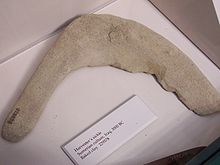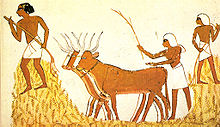|
|
iculture, also called farming or husbandry, is the cultivation of animals, plants, fungi, and other life forms for food, fiber, biofuel and other products used to sustain human life.[1] Agriculture was the key development in the rise of sedentary human civilization, whereby farming ofdomesticated species created food surpluses that nurtured the development of civilization. The study of agriculture is known as agricultural science. Agriculture generally speaking refers to human activities, although it is also observed in certain species of ant and termite.[2][3] The word agriculture is the English adaptation of Latin agricultūra, from ager, "a field",[4] and cultūra, "cultivation" in the strict sense of "tillage of the soil".[5] Thus, a literal reading of the word yields "tillage of fields".
The history of agriculture dates back thousands of years, and its development has been driven and defined by greatly different climates, cultures, and technologies. However, all farming generally relies on techniques to expand and maintain the lands that are suitable for raising domesticated species. For plants, this usually requires some form of irrigation, although there are methods of dryland farming; pastoral herding on rangeland is still the most common means of raising livestock. In the developed world, industrial agriculture based on large-scale monoculture has become the dominant system of modern farming, although there is growing support for sustainable agriculture (e.g. permaculture or organic agriculture).
Until the Industrial Revolution, the vast majority of the human population labored in agriculture. Pre-industrial agriculture was typically subsistence agriculture in which farmers raised most of their crops for their own consumption instead of for trade. A remarkable shift in agricultural practices has occurred over the past century in response to new technologies, and the development of world markets. This also led to technological improvements in agricultural techniques, such as the Haber-Bosch method for synthesizing ammonium nitrate which made the traditional practice of recycling nutrientswith crop rotation and animal manure less necessary.
Modern agronomy, plant breeding, pesticides and fertilizers, and technological improvements have sharply increased yields from cultivation, but at the same time have caused widespread ecological damage and negative human health effects.[6] Selective breeding and modern practices in animal husbandry such as intensive pig farming have similarly increased the output of meat, but have raised concerns about animal cruelty and the health effects of the antibiotics, growth hormones, and other chemicals commonly used in industrial meat production.[7]
The major agricultural products can be broadly grouped into foods, fibers, fuels, and raw materials. In the 21st century, plants have been used to growbiofuels, biopharmaceuticals, bioplastics,[8] and pharmaceuticals.[9] Specific foods include cereals, vegetables, fruits, and meat. Fibers include cotton, wool, hemp, silk and flax. Raw materials include lumber and bamboo. Other useful materials are produced by plants, such as resins. Biofuels includemethane from biomass, ethanol, and biodiesel. Cut flowers, nursery plants, tropical fish and birds for the pet trade are some of the ornamental products. Regarding food production, the World Bank targets agricultural food production and water management as an increasingly global issue that is fostering an important and growing debate.[10]
In 2007, one third of the world's workers were employed in agriculture. The services sector has overtaken agriculture as the economic sectoremploying the most people worldwide.[11] Despite the size of its workforce, agricultural production accounts for less than five percent of the gross world product (an aggregate of all gross domestic products).
[edit]History
Agricultural practices such as irrigation, crop rotation, fertilizers, pesticides and animals were developed long ago, but have made great strides in the past century. The history of agriculture has played a major role in human history, as agricultural progress has been a crucial factor in worldwide socio-economic change. Division of labor in agricultural societies made commonplace specializations rarely seen in hunter-gatherer cultures. So, too, are arts such as epic literature and monumental architecture, as well as codified legal systems. When farmers became capable of producing food beyond the needs of their own families, others in their society were freed to devote themselves to projects other than food acquisition. Historians and anthropologists have long argued that the development of agriculture made civilization possible. The total world population probably never exceeded 15 million inhabitants before the development of agriculture.[12]
[edit]Prehistoric origins
Forest gardening, a plant-based food production system, is thought to be the world's oldest agroecosystem.[13] Forest gardens originated in prehistorictimes along jungle-clad river banks and in the wet foothills of monsoon regions. In the gradual process of a family improving their immediate environment, useful tree and vine species were identified, protected and improved whilst undesirable species were eliminated. Eventually superior foreign species were selected and incorporated into the family's garden.[14]
[edit]Ancient history
The Fertile Crescent of Western Asia, Egypt, and India were sites of the earliest planned sowing and harvesting of plants that had previously been gathered in the wild. Independent development of agriculture occurred in northern and southern China, Africa's Sahel, New Guinea and several regions of America.[15] The eight so-called Neolithic founder crops of agriculture appear: first emmer wheat and einkorn wheat, then hulled barley, peas, lentils, bitter vetch, chick peas and flax.
By 7000 BC, small-scale agriculture reached Egypt. From at least 7000 BC the Indian subcontinent saw farming of wheat and barley, as attested by archaeological excavation at Mehrgarh inBalochistan in what is present day Pakistan. By 6000 BC, mid-scale farming was entrenched on the banks of the Nile. This, as irrigation had not yet matured sufficiently. About this time, agriculture was developed independently in the Far East, with rice, rather than wheat, as the primary crop. Chinese and Indonesian farmers went on to domesticate taro and beans including mung,soy and azuki. To complement these new sources of carbohydrates, highly organized net fishing of rivers, lakes and ocean shores in these areas brought in great volumes of essential protein. Collectively, these new methods of farming and fishing inaugurated a human population boom that dwarfed all previous expansions and continues today.



